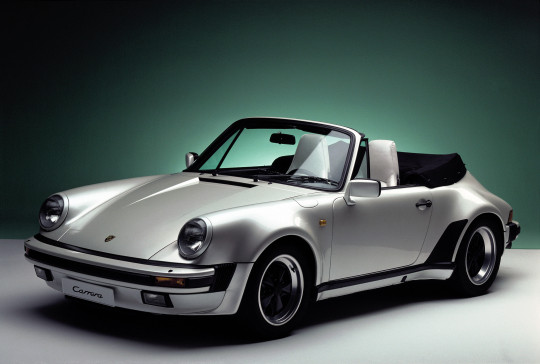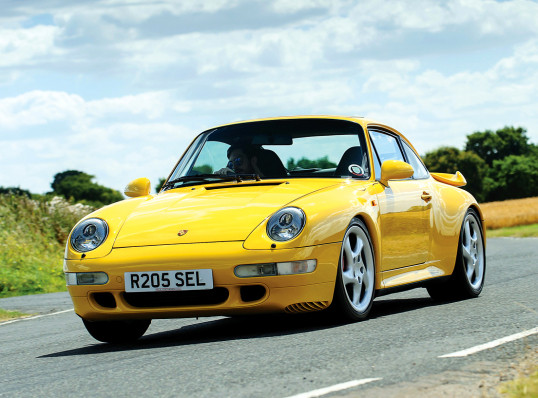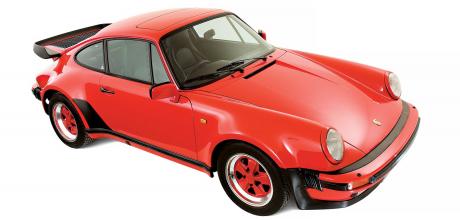History of Porsche 911 wide bodies
Liked the looks of the Turbo but could live without the performance? Porsche had an answer with the Turbo-look, wide-bodied 911 Carrera.
Discover how Porsche created and evolved its famous Turbo-look Carrera through the year
Back in the 1980s, wanting to make your Porsche 911 stand out was nothing new. Hand your car over to companies such as Strosek, Gemballa and Rinspeed, and they would turn it into something special, and what many owners wanted particularly was the widebody look exemplified by the Turbo. The results weren’t always tasteful, but they were distinctive, and if your budget didn’t stretch to a specialist tuner then you could opt for one of the myriad glass-fibre kits that were available at a fraction of the price.

It was a trend that didn’t go unnoticed by Porsche and in 1984 it made option ‘M491’ available. For the first time you could buy a naturally aspirated 3.2-litre Carrera and equip it with the flared wheel arches and dramatic tea-tray spoiler of the contemporary Turbo. Known as the ‘Turbo look’, it was officially designated ‘SSE’ for ‘Super Sport Equipment’ (and later just ‘Super Sport’), and it was a look that was to become hugely popular, especially in the US, where the Turbo had been temporarily withdrawn from sale after falling foul of stringent emissions legislation.

Initially available in Coupe form only, the option was made available on Targa and Cabriolet models from 1986, and while UK sales weren’t huge – exact numbers are hard to come by, as factory records don’t distinguish the wide-body cars from other models, but it’s thought to be around 75 – Porsche had hit on a style that would remain for a number of 911 generations. Ticking that particular option box meant buyers got more than just a 123mm wider body on standard running gear, because the SSE also utilised some of the tasty suspension and brake upgrades that until now had been the preserve of the Turbo. Among other tweaks, that meant larger torsion bars and anti-roll bars, beefed-up trailing arms, cross-drilled brakes with four-piston calipers and the fitment of 16-inch Fuchs wheels as standard.
While it handled and stopped better than a standard Carrera – and was arguably better looking, too – as its detractors were keen to point out, there were some downsides to the transformation, not least of which was extra weight. The new model was reckoned to be close to 70kg heavier than a ‘narrow’ car, which with a greater frontal area blunted performance a little, lopping 12mph from the top speed. For a touch more subtlety, buyers could also choose option M470, which deleted the front and rear spoilers, but either way an SSE wasn’t cheap. In 1984 you’d have spent just over £6,000 more than on a regular Carrera, the amount jumping to four figures just a few years later.
The purists may have viewed it as form over raked windscreen, Porsche removed the rear seats and fitted a smaller and lighter convertible hood beneath a humped fibreglass cover (Porsche reportedly made it clear to buyers that the hood was for emergencies only, and any claims for damage from water leaks were likely to be firmly rebuffed). Where it fits into this story is that despite offering the Speedster in both standard and ‘Turbo-look’ forms, the latter was to prove more popular. Of the 2,103 cars built, just 171 were of the narrow-bodied variety, so Porsche was clearly on to something, and despite the mixed reviews it wasn’t finished with the Speedster theme.
Based on the Carrera 2 Cabriolet, the 964 Speedster was launched in 1992 for the 1993 model year, and Porsche planned a production run of 3,000 cars, almost all of which would be narrow-bodied. Aided by a reduced kit-count, the Speedster was lighter than the C2 Cabrio, although many owners raided the options list to add niceties like air-conditioning and a limited-slip differential, and most examples sported lightweight ‘RS’ seats and Cup alloys. The limitations of the thinner manual hood weren’t something that bothered the majority of buyers in the US, where the model proved especially popular (just 14 or so cars are thought to be right-hand drive). In the event, and despite high expectations from Porsche, only 936 were built, but it’s the last few of those that interest us here. At considerable extra cost, 20 Turbo-look examples were built by Porsche’s Exclusive workshop, and these are especially sought after today.
For those that admired the broader-hipped body style, the 964 generation provided rich pickings, as Porsche introduced two further naturally aspirated derivatives. First up was the 964 C2 Turbo-look Cabriolet, which was available for the 1992 model year. It proved popular with buyers, blending the wider bodywork of the Turbo with the pop-up electric spoiler fitted to standard 964s and adding 17-inch ‘Cup’ alloys and aerodynamic ‘teardrop’ door mirrors. The suspension was swapped for the setup beneath the Turbo model, and there was a choice of manual or Tiptronic gearboxes, although the latter blunted performance somewhat, adding almost a second to the claimed 0-62mph time. Almost as hard to swallow as the name, though, was the price: north of £70,000 when new, and that was before you started dipping into the options list.
Another 964 to receive the Turbo-look treatment was the 30th Anniversary model launched at the 1993 Geneva Show and available only as a Coupe, but again retaining the standard retractable spoiler. Although exact numbers vary depending on the source – 894 are thought to have been registered, confused somewhat by the addition of a further 174 Turbo-look C4s that lacked anniversary badging – 911 examples were planned with standard colours limited to Viola, Polar silver and Amethyst, although both Guards red and green examplesfunction, but Porsche wasn’t to be deterred, and retained the look for another variation of the Carrera: the Speedster. First shown at the 1987 Frankfurt Motor Show, it didn’t garner universal acclaim, but was distinctive. As well as a shorter, more steeply were said to have been built. Porsche went to town on the specification, though, with buyers getting air-conditioning, leather trim and a full suite of airbags, along with an interior plaque and logos and underlined ‘911’ script on the engine cover. Once again, curb weight suffered, with approximately 50kg added over a narrow-bodied C4 and the extra panelling reducing the top speed.
The introduction of the last of the air-cooled cars, the 993 generation, provided Porsche with yet another opportunity to satisfy Turbo-style cravings. 1996 saw the introduction of the C4S, which with an extra three inches or so of width was essentially a 993 Turbo without the blower. An electric rear spoiler was standard – the lack of an intercooler meant the fixed item wasn’t required, although you could opt for it for the complete look, but under the skin you got lower suspension and the hugely effective Turbo brakes. The 18-inch ‘Cup 3’ wheels were standard, though with solid rather than hollow spokes, and there was plenty of interior kit, including full-leather trim and electric seats. Given the modest output compared to the Turbo, the chassis modifications weren’t strictly necessary, but they didn’t harm the driving experience.
If you preferred not to lug around the extra all-drive hardware, then the C2S launched in 1997 would no doubt have suited your needs rather well. Retaining the standard C2 underpinnings apart from 10mm lower suspension and with the retractable spoiler only, you did, however, get larger 17-inch Cup wheels (the inch larger Turbo items were optional) and some interior tweaks to remind you where your extra money had gone. In all, Porsche produced 10,662 of these particular 993s, 6,948 being C4S models, although these are actually rarer in the UK than the Turbo it aimed to replicate.
Clearly, then, 911 enthusiasts that appreciated the style but didn’t want the complexity and performance of a Turbo were well catered for, but what of buying and owning one today? Well, the first thing you’re getting – two-seater Speedster models aside – is a very useable 911, one that retains the practicality and driveability of the standard car, and that has to be good news for the majority of us. Not that they were all unanimously praised by the motoring press of the day; some journalists questioned the wisdom of paying extra for a car that was slower than the Turbo it mimicked.
The other thing you’ll be buying into is rarity, depending on the model, which is more good news when it comes to values and saleability. Each of these cars are sought after, and some will have ended up in collections, so it’s more than likely that seeking out one of these special 911s will prove to be a wise investment in the long run. Speak to specialists and they’ll likely tell you that anything Turbo-bodied will fetch more money.
Aside from the caveats that accompany any older 911, ownership shouldn’t prove troublesome either. The Turbo-derived suspension and brake components may cost a little more, and you probably wouldn’t want to damage the parts that make the Speedster models so unusual, but there are few other downsides. A winning formula, then? Most definitely, and one that Porsche was more than happy to carry into a whole new generation: the water-cooled 996.
The change to water-cooling may have been a momentous one, but it didn’t affect the appetite of buyers for a Turbo-look widebody model, and Porsche obliged in late 2001 by introducing the 996 C4S. Underneath the wider wings (which lacked the air intakes of the Turbo), you’d find a broader track, lower suspension and ‘big red’ brakes. The package was topped off with 18-inch wheels, and there was a more luxurious interior as well as a red reflector panel between the rear lights. The security of all-wheel drive meant owners could fully exploit the 320bhp on offer, too.
Alas the 996 C4S was the last truly Turbo-look 911 Carrera. By the turn of the 997-generation 911, the AWD C4S had its own style that wasn’t based on the Turbo, a trait which has carried on to this day. By the 991, it was the GT3 RS that used the Turbo body, albeit with lightweight materials used, not to mention a large rear wing.
The Turbo-look Carrera was thus resigned to the motoring history books as of 2005, but today they remain sought-after 911s, no matter the generation they hail from.
ABOVE The 996 Carrera 4S was Porsche’s final Turbo-look Carrera. It was introduced in 2001 and came with a generous interior package, including electrically adjustable seats and allleather upholstery and trim
BELOW 993 C2S and C4S came with Turbo shell, alloy wheels and brakes. However, spokes on the C2S and C4S weren’t hollow, unlike those on the 993 Turbo (BELOW RIGHT) TOP RIGHT A 964 Anniversary utilised the widebody shell
BELOW Despite their popularity in left-hand-drive form, just 75 examples were built by Porsche in right-hand drive. Of that 75, just 26 are known to be Cabriolets (BELOW RIGHT)
TOP RIGHT Widebody 3.2 Speedsters were relatively popular
MANY OWNERS WANTED THE WIDEBODY LOOK OF THE TURBO. THE RESULTS WEREN’T ALWAYS TASTEFUL, BUT THEY WERE DISTINCTIVE
The classic widebody line-up
- Carrera 3.2 SSE 1984-1989 The first official 911 to feature the Turbo look, along with suspension and brake upgrades. UK sales were modest, but it’s popular now.
- Carrera 3.2 Speedster 1989-1990 Unusual looks characterised the Speedster models, and it wasn’t admired by all. Most were Turbo look; many ended up in collections.
- 964 Speedster 1993-1994 Porsche stuck with the Speedster theme, although less than 1,000 were made. The few widebody models are extremely rare today.
- 964 C2 Turbo-look Cab 1992-1993 Terrible name but great looks. Not cheap though, and performance was blunted by the Tiptronic gearbox – though the majority were manuals.
- 964 Anniversary 1993-1994 Luxurious specification and special trimmings went with the Turbo-esque wide arches and 17-inch ‘Cup’ wheels.
- 993 C4S 1996-1998 The only thing missing was the Turbo. Handling and stopping were first-rate thanks to the Turbo chassis.
- 993 C2S 1997-1998 It lacked the suspension and brake tweaks of the 4S, although the 2WD layout reduced the weight penalty


